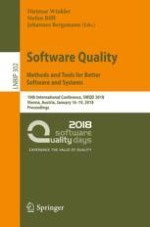This book constitutes the refereed proceedings of the 10th Software Quality Days Conference, SWQD 2018, held in Vienna, Austria, in January 2018.
The Software Quality Days (SWQD) conference started in 2009 and has grown to the biggest conferences on software quality in Europe with a strong community. The program of the SWQD conference is designed to encompass a stimulating mixture of practical presentations and new research topics in scientific presentations. The guiding conference topic of the SWQD 2018 is “Software Quality 4.0: Methods and Tools for better Software and Systems”, as novel technologies include new challenges and might require new and adapted methods and tools to support quality assurance activities early.
The 6 full papers and 2 short papers presented in this volume were carefully reviewed and selected from 16 submissions. The volume also contains 2 invited talks. The contributions were organized in topical sections named: safety and security; requirements engineering and requirements-based testing; crowdsourcing in software engineering; software and systems architecture; experimentation in software engineering; and smart environments.
